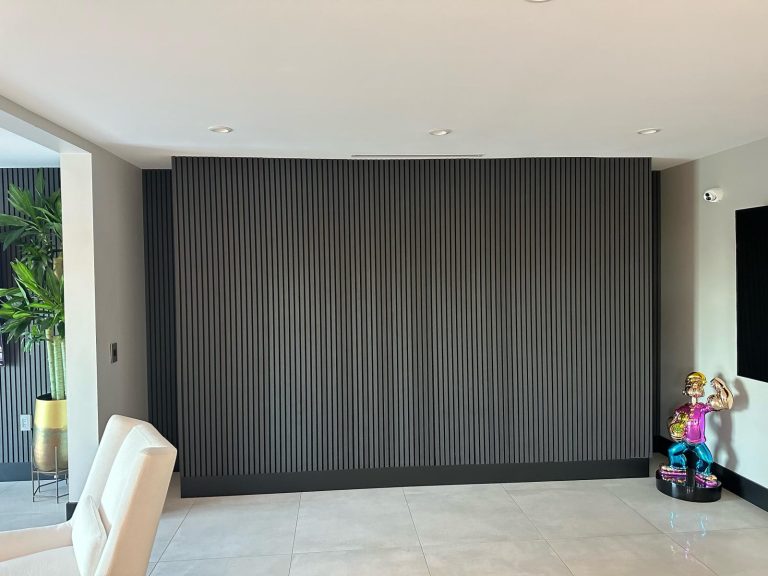
Elevate Your Interior Design with Wooden Wall Panels
Wooden wall panels are a great way to bring warmth, texture, and refinement into any house. Whether you’re designing a comfortable rustic refuge or a sleek modern area, these panels offer versatility, durability, and timeless appeal. Wooden wall panels are attractive and functional, and they come in a variety of shapes, finishes, and mounting options. Many homeowners choose
for a stylish and durable interior upgrade.
This article will go over the benefits of wooden wall panels, popular styles, installation methods, maintenance recommendations, and commonly asked questions to help you make an informed decision for your house.
Why Choose Wooden Wall Panels?
Wooden wall panels serve more than just a cosmetic purpose. They have various practical advantages, making them a good investment.
Aesthetic Appeal and Timeless Beauty
- Wooden panels provide depth and texture to walls, providing a warm and inviting ambiance.
- They are available in a variety of textures, hues, and finishes, making them suitable for both classic and modern environments.
- Natural stains and painted finishes can be customized to create a unique look.
Improved Comfort and Insulation
- Wood naturally regulates indoor temperatures, keeping rooms warm in the winter and cool in the summer.
- Wooden panels absorb sound, decreasing echoes and making places feel more peaceful.
Durability and Longevity
- High-quality wooden wall panels withstand daily use and can last for decades with proper maintenance.
- Unlike wallpaper or paint, they can resist scuffs and minor damage without requiring repeated touch-ups.
Types of Wooden Wall Panels
Different varieties of wooden wall panels provide unique design options. Choosing the proper style can improve the atmosphere of any area. Experts recommend
to achieve a balance between aesthetics and functionality.
Reclaimed Wood Panels
These salvaged wood panels add rustic beauty with apparent knots, grains, and textures. They are an environmentally friendly choice that adds charm to walls.
Shiplap Panels
Shiplap panels have horizontal planks that fit together snugly. They look great in farmhouse, coastal, and modern settings, providing a clean yet homey aesthetic.
Beadboard Panels
Beadboard is made of vertical slats separated by grooves. This style complements traditional and cottage-inspired interiors and is frequently utilized for wainscoting or full-wall paneling.
3D Textured Panels
3D panels create depth and visual interest on walls, making them great for statement walls in living areas or bedrooms.
Geometric Wooden Panels
These panels produce complicated patterns using various wood forms and angles, making them ideal for a bold modern look.
Choosing the Right Wooden Wall Panels
The best wooden wall panels are chosen based on your design goals, room conditions, and installation preferences.
Room Functionality
- In moisture-prone places such as bathrooms, use treated or moisture-resistant wood panels.
- For high-traffic areas, select a robust wood that can survive repeated use.
Interior Style
- Reclaimed wood panels with natural blemishes work well in rustic homes.
- Minimalist interiors look best with sleek, painted shiplap or geometric patterns.
- Beadboard complements traditional designs and adds a timeless touch.
Installation and Maintenance Considerations
- Some panels, such as peel-and-stick versions, are simple to install on your own.
- Professional installation may be necessary for elaborate designs or huge wall expanses.
- Regular care, such as dusting and refinishing, helps panels look their best.
Installing Wooden Wall Panels: A Step-by-Step Guide
When done correctly, wooden wall panels can be placed efficiently. Follow these procedures to ensure a smooth process.
Tools Needed
- Measuring tape
- Level
- Saw used to cut panels to size.
- Nails, screws, or glue.
- Sandpaper
- Paint or stain the wood (if finishing is required)
Installation Process
- Prepare the Wall – To improve adhesion, clean the surface and remove any dust or dirt.
- Measure and Cut Panels – Measure the area precisely and cut panels to fit.
- Acclimate the Wood – Allow panels to acclimate to the room temperature and humidity for at least 48 hours.
- Attach Panels – Use nails, screws, or a strong adhesive to secure them.
- Apply Finishing Touches – Sand any rough edges and, if wanted, stain or paint them.
Maintaining Wooden Wall Panels
Follow these care tips to keep your wooden wall panels looking and functioning well.
- Regular Dusting – To prevent buildup, use a soft cloth or a microfiber duster.
- Avoid Excess Moisture – Rather than using water, wipe with a slightly moist cloth.
- Refinish When Needed – Apply protective coatings or stains every few years to ensure long-term durability.
Frequently Asked Questions (FAQ)
Are wooden wall panels expensive?
The cost varies according to the wood type, design, and installation method. Pre-made panels are a more affordable alternative to reclaimed wood and unique designs.
Can I install wooden wall panels myself?
Yes, many panels, such as peel-and-stick or tongue-and-groove varieties, are intended for DIY installation. Professional installation is recommended for complex designs.
Are wooden wall panels suitable for humid environments?
Some timber panels have been coated with moisture-resistant coatings, making them excellent for bathrooms and kitchens. Regular maintenance helps to prevent warping and damage.
How do I remove stains or scratches from wooden wall panels?
For light stains, use a wet cloth and mild soap. For deeper scratches, sanding and refinishing may be required.
Do wooden wall panels add value to a home?
Yes, they improve a home’s aesthetic appeal and market value by providing a timeless and high-end appearance.
Why Choose Wooden Wall Panels?
Wooden wall panels are both elegant and functional additions to any home. Whether improving a single room or remodeling an entire space, they provide the ideal balance of beauty, durability, and warmth. With proper selection, installation, and upkeep, these panels can enhance the interior of your house for years to come. Many modern interiors incorporate
for added texture and depth.
